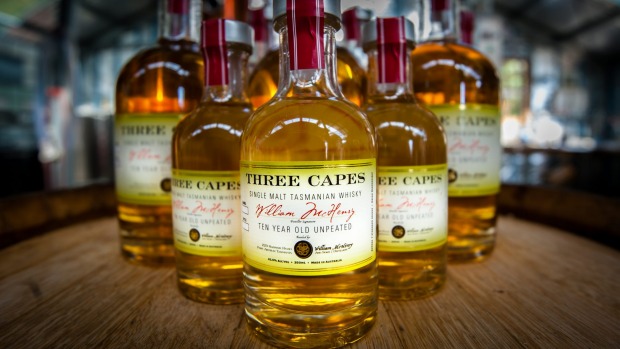
The first cellar door on the list is also the first distillery to start in Tassie, after an 1839 ban on distilling by then governor John Franklin who was trying to curtail public drunkenness (he allowed brewing though, 'cos he didn't want a riot). As the first person to challenge the ban, Bill Lark is recognised as the grandfather – or godfather depending on whom you talk to – of the Tasmanian whisky industry. Lark Distillery was started in 1992 with barley borrowed from the Cascade brewery, which Lark believes gives Tasmanian whisky a distinctive terroir: "Tasmania is getting a name for itself throughout the world market for having that very creaming, oily texture as it rolls across your palate," he says. The distillery produces a range of aged single malts, Forty Spotted gin (the baby of Lark's wife Lyn) and whisky liqueurs and they can all be found at the Hobart waterfront cellar door. "We at Lark Distillery believe the future for Tasmanian whisky is through tourism," says Lark. "The vast majority of us travel to experience the culture of a place through its food and beverages and I see for us the greatest marketing tool is to look after visitors who come to our distillery."
Hobart, see larkdistillery.com and taswhiskytrail.com
Named after one of the first European explorers to arrive in north-west Tasmania, this distillery sprang from an unlikely source. Boutique milk co-operative Betta Milk was established in 1956 and now consists of over 30 farming families. Looking to diversify, CEO Mark Littler decided if they could make great milk, they could also make great whisky. "In 1999 and $10 million later we invested in a distillery in Burnie and opened a visitors centre in 2006," says Littler.
The distillery now exports to 20 European countries and has a special whisky finished in Tassie's own pinot noir barrels, as well as the more traditional bourbon and port barrel options. The visitor's centre, overlooking the Emu Valley, offers a fully licensed restaurant and a Tasting Bar to sample the wide range of whiskies on offer – and given the company's dairy history you cannot go past the whisky milk!
Burnie, see hellyersroaddistillery.com.au
Tree-changer William McHenry left a Sydney biotech company to move to Tasmania for the purpose of making whisky and with the handful of others in this fledgling industry he formed the Tasmanian Whisky Producers Association. The distillery sits on the Tasman Peninsula making it the country's southernmost distillery, the land has excellent spring water too, the basis for a great whisky. As the name suggests McHenry's is a family affair and offers tours of the distillery by appointment and while the Three Capes single malt whisky is a cracker it is the gin that makes McHenry's stand out. The McHenry Classic Dry Gin is a wonderfully floral gin with the botanicals taking centre stage. It was recently named Australia's finest gin by Australian Gourmet Travel in a tasting of 23 Aussie gins.
Port Arthur, see mchenrydistillery.com.au
Founded in 1995 at the titular cove in Hobart, that once housed one of the island's first British settlements in 1804, this distillery recently moved to brand new digs in Cambridge. Master distiller Patrick Maguire has helped boost Tasmanian whisky's already growing reputation by taking out the World's Best Whisky at the World Whiskies Awards in London last year. It was a great birthday present for Sullivans Cove as the distillery celebrated its 20th anniversary and just the latest in a string of awards for their Sullivans Cove French Oak whisky. The Sullivans Cove Cellar Door offers hourly tours during the week, but bookings are preferred.
Cambridge, see sullivanscovewhisky.com
Specialising in just a handful of single malt whiskies, Nant was started by Keith Batt. Nant single malts are aged in American Oak sherry barrels, bourbon barrels and French Oak pinot noir barrels and you can visit the cellar door most days. The estate dates back to the 1800s and is also home to Australia's oldest water-powered flour mills which are part of the guided tour. Plan to have a meal at the Atrium restaurant that has sweeping views of the Tasmanian highlands as well as a seasonal menu and tasting flights of whisky matched with the food. Nant means "stream" and the whole area was named that by Welsh settlers after it's pure drinking water, so it is the perfect place for a distillery.
Bothwell, see nant.com.au
This is the new kid with the first release of single malt only becoming available later this year and the business moving next month (February) to an old coaching in at Kempton, about 50 kilometres north of Hobart. Stables built from convict-made bricks once hosted 20-or so horses and now house Redlands' copper still. The main residence of the old inn will be the cellar door and cafe. While you wait for the release of the single malt, you can taste Redlands other offerings; apple schnapps, apple liquor, XO brandy and New Malt – a spirit, based on the barley that will eventually be seen in the newest whisky off the Tasmanian block.
Kempton, see redlandsestate.com.au.